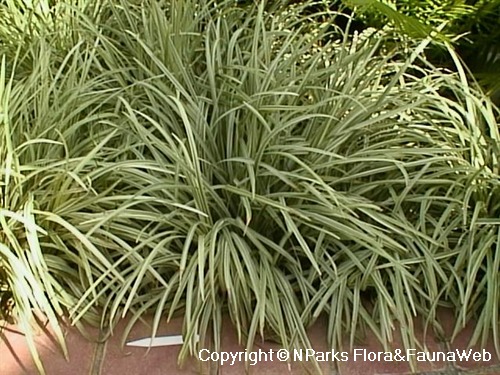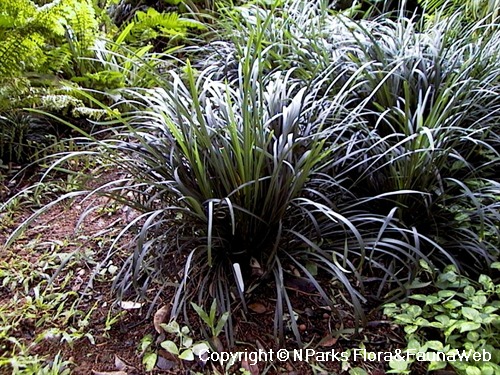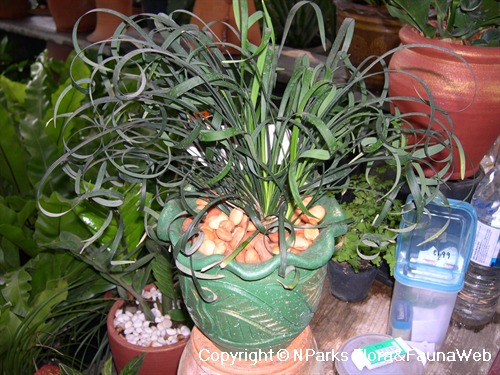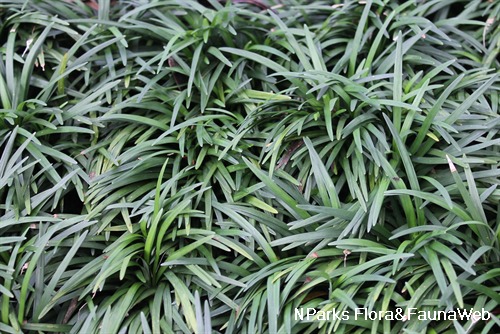.jpg)
Back
Ophiopogon japonicus (Thunb.) Ker Gawl.
| Family Name: | Asparagaceae |
| Synonyms: | Convallaria japonica Thunb., Liriope gracilis (Kunth) Nakai, Mondo japonicum (Thunb.) Farw., Mondo stolonifer (H.Lév. & Vaniot) Farw., Ophiopogon argyi H.Lév., Ophiopogon gracilis Kunth, Ophiopogon merrillii Masam., Ophiopogon stolonifer H.Lév. & Vaniot |
| Common Name: | Dwarf Lilyturf, Mondo Grass, 麥冬 |
Ophiopogon japonicus or Dwarf Lilyturf is a short grass-like herb that grows to 30 cm tall. The leaves are dark green in colour, linear, 20 - 40 cm long, about 0.5 cm wide. Flowers are small, bell-shaped, pale lilac to white, borne on an inflorescence. It produces round to elliptic fruits that are cobalt blue in colour measuring less than 1 cm wide. This compact herb is a suitable as a groundcover or grass substitue due to its low maintenance and turf-like nature.
Name
Classifications and Characteristics
| Plant Division | Angiosperms (Flowering Seed Plants) (Monocotyledon) |
|---|---|
| Plant Growth Form | Herbaceous Plant |
| Plant Shape | Grassy |
| Maximum Height | 0.3 |
Biogeography
| Native Distribution | Central & South China to Vietnam, Eastern Asia to Philippines |
|---|---|
| Native Habitat | Terrestrial (Inland Cliff, Mountain, Temperate Forest) |
| Preferred Climate Zone | Tropical |
| Local Conservation Status | Non-native |
Description and Ethnobotany
| Growth Form | It is a short grass-like herb that reaches to 30 cm tall, it has rhizomes that are short or poorly developed. |
|---|---|
| Foliage | Its leaves are narrow, linear, with a round to sharp tip. The dark green leaves are 20 - 40 cm long, about 0.5 cm wide. |
| Flowers | Its flowers are borne on a raceme inflorescene. Each inflorescence have between 10 - 15 small, bell-shaped flowers. The 6 petalled flowers are pale lilac to white in colour, partially hidden within the foliage held on a flowe stalk measuring at 10 - 35 cm long. |
| Fruit | Its fruits are berry-like, cobalt blue in colour measuring less than 1 cm wide. Each fruit bears up to 6 seeds that are round to elliptic, 4 mm long. |
| Others - Plant Morphology | It has underground stolons or runners which creates a turf-like appearance. |
| Habitat | Found in shaded damp grounds of lowlands, foothills and slopes, along streams, mossy forest, dense scrub in ravines, and cliffs at elevations from 200 - 2,800 m. |
| Cultivation | Prefer for sandy soils but does well in any moist, fertile, well-drained soil. This species is salt tolerant and can be grown as a submerged aquatic plant. |
| Etymology | The genus, Ophiopogon is derived from the greek words, Ophis meaning snake and Pogon meaning beard. The species epithet, japonicus refers to its native habitat, Japan |
Landscaping Features
| Landscape Uses | Groundcover, Parks & Gardens, Riverine, Slope Stabilization, Coastal Plant, Indoor Plant |
|---|
Plant Care and Propagation
| Light Preference | Semi-Shade, Full Shade |
|---|---|
| Water Preference | Moderate Water |
| Plant Growth Rate | Fast |
| Rootzone Tolerance | Well-Drained Soils, Moist Soils, Fertile Loamy Soils |
| Propagation Method | Division, Stolon / Runner, Seed |
Foliar
| Foliage Retention | Evergreen |
|---|---|
| Mature Foliage Colour(s) | Green |
| Foliar Type | Simple / Unifoliate |
| Foliar Arrangement Along Stem | Basal |
| Foliar Attachment to Stem | Sessile |
| Foliar Venation | Parallel |
| Foliar Margin | Entire |
| Foliar Apex - Tip | Acute |
Non - Foliar and Storage
| Stem Type & Modification | Runner / Stolon |
|---|---|
| Root Type |
Floral (Angiosperm)
| Flower & Plant Sexuality | Bisexual Flowers , Bisexual Flowers |
| Flower Colour(s) | White, Purple |
|---|
| Flower Grouping | Cluster / Inflorescence |
| Flower Location | Axillary |
| Flower Symmetry | Radial |
| Individual Flower Shape | Campaulate / Bell-shaped |
| Inflorescence Type | Raceme |
| Flowering Habit | Polycarpic |
Fruit, Seed and Spore
| Mature Fruit Colour(s) | Blue |
|---|---|
| Fruit Classification | Simple Fruit |
| Fruit Type | Fleshy Fruit , Fleshy Fruit |
References
| References | Jessop, J.P. (1979). Flora Malesiana - Series 1, Spermatophyta, 9(1), 189-235. Nesom, G.L. (2010). Overview of Liriope and Ophiopogon (Ruscaceae) naturalized and commonly cultivated in the USA. Phytoneuron 2010-56: 1–31. Royal Botanic Gardens, Kew (continuously updated). Plants of the World Online | Kew Science. http://www.plantsoftheworldonline.org/taxon/urn:lsid:ipni.org:names:429781-1. Accessed 5 November 2021. Missouri Botanical Garden (continuously updated). Missouri Botanical Garden – Plant Finder. https://www.missouribotanicalgarden.org/PlantFinder/PlantFinderDetails.aspx?taxonid=282276&isprofile=0&. Accessed 5 November 2021 North Carolina Cooperative Extension (continuously updated). North Carolina Extension Gardener Plant Toolbox. https://plants.ces.ncsu.edu/plants/ophiopogon-japonicus/. Accessed 5 November 2021 |
|---|
Image Repository
Others
| Master ID | 34129 |
|---|---|
| Species ID | 8542 |
| Flora Disclaimer | The information in this website has been compiled from reliable sources, such as reference works on medicinal plants. It is not a substitute for medical advice or treatment and NParks does not purport to provide any medical advice. Readers should always consult his/her physician before using or consuming a plant for medicinal purposes. |

.jpg)
.jpg)



